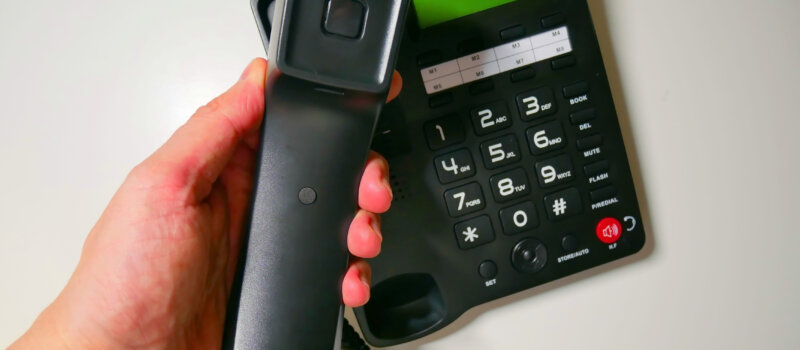As businesses upgrade to faster, smarter communication systems, many are asking a simple question: what is a POTS line, and do we still need it?
POTS, short for Plain Old Telephone Service, refers to the traditional analog voice transmission system that runs over copper wires. Once the backbone of global telephony, this system is being phased out in favor of digital and cloud-based alternatives like VoIP. For businesses still relying on legacy phone lines, understanding what a POTS line is (and why it’s going away) has become more urgent than ever.
Quick Takeaways
- A POTS line is a traditional analog phone line that transmits voice calls over copper wires.
- These lines are being retired by major carriers due to high costs and limited functionality.
- Businesses still using POTS risk outages, high fees, and compatibility issues.
- Alternatives like VoIP, cloud PBX, and SIP trunking offer modern, flexible, and cost-effective communication.
- Migrating away from POTS requires planning but results in better scalability, reliability, and integration.
What Is a POTS Line?
A POTS line is the original analog telephone system, using a pair of copper wires to transmit voice calls. It relies on circuit-switched technology, which establishes a dedicated connection between two endpoints for the duration of a call.

This system has been around for over a century. Despite its age, it’s known for its reliability. POTS lines continue to function during power outages, and they offer consistent audio quality with no reliance on internet service.
But that simplicity comes with trade-offs,especially in a time where businesses need integrated, flexible, and feature-rich communication tools.
A Short History of POTS
POTS lines originated with the Bell System in the late 1800s and became the standard for residential and business telephony well into the 20th century. For decades, homes and offices operated on this copper infrastructure, with physical switching stations routing calls across the country.
The system worked. It was dependable, relatively easy to maintain, and nearly universal. Businesses used it not only for voice calls but also for fax machines, credit card terminals, and alarm systems.
However, the introduction of broadband internet, mobile phones, and VoIP gradually eroded the dominance of POTS. As fewer people used landlines and maintenance costs rose, telecom carriers began retiring copper lines in favor of more scalable and cost-effective digital systems.
Where POTS Lines Are Still Used
Although most businesses have already shifted to digital systems, POTS lines still remain in use for several reasons:
- Alarm and fire panels: Many legacy alarm systems rely on analog dialers connected via POTS.
- Elevator emergency phones: Building codes often require a reliable voice line in elevators, and many still use copper.
- Fax machines: Especially in healthcare and legal sectors, traditional faxing over analog lines remains common.
- Rural locations: In areas with limited broadband access, POTS lines may still be the most stable option.
- Backup systems: Some organizations maintain a POTS line as a failsafe in case of internet outages.
But these use cases are shrinking. Vendors and service providers are encouraging users to upgrade before analog support disappears altogether.
Why POTS Lines Are Being Phased Out
Several factors are accelerating the retirement of POTS lines:
- High maintenance costs: Copper infrastructure is expensive to maintain and prone to degradation over time.
- FCC deregulation: In 2019, the FCC allowed carriers to stop supporting legacy analog systems if they offer IP-based alternatives.
- Declining usage: As more customers adopt VoIP and mobile services, telecoms are shifting investments away from aging copper networks.
- End of manufacturer support: Hardware providers are no longer producing new analog parts, making repairs harder and more expensive.
Major carriers, including AT&T and Verizon, have already announced plans to sunset POTS services in many regions. The cost of keeping a POTS line active continues to rise, with some providers charging hundreds of dollars per month for legacy maintenance.
Limitations of POTS Lines for Businesses
Businesses that continue using POTS lines face a number of limitations:
- Lack of scalability: Adding new lines requires physical installation, which is time-consuming and costly.
- Limited functionality: POTS doesn’t support video calls, voicemail-to-email, call analytics, or CRM integration.
- No support for hybrid work: Remote teams need flexible, cloud-based communication tools that POTS simply doesn’t offer.
- Service disruptions: Aging copper lines are vulnerable to damage from weather, corrosion, and construction.
- High total cost of ownership: Between rising line rental fees and maintenance costs, analog lines are often more expensive than digital alternatives.
Modern Alternatives to POTS
Businesses have several viable alternatives to traditional copper lines:
VoIP (Voice over Internet Protocol)
VoIP uses an internet connection to transmit voice calls, replacing the need for physical copper lines. It’s a cost-effective solution that supports advanced features like call forwarding, voicemail-to-email, and call analytics.

Because VoIP is software-based, it scales easily as your business grows and integrates seamlessly with cloud applications and mobile devices.
Cloud-Based Phone Systems
Cloud-based phone systems go beyond voice by offering unified communication tools in one platform—voice, video, messaging, and file sharing. These systems are ideal for remote and hybrid teams, with centralized management, automatic updates, and built-in redundancy. Businesses benefit from better collaboration and lower maintenance compared to on-premises solutions.
SIP Trunking
SIP trunking allows businesses to connect their existing PBX hardware to the internet for voice calls. It’s often used as a transitional solution for organizations that want the benefits of IP-based calling without replacing their entire system. SIP reduces telecom costs, increases reliability, and helps bridge the gap between legacy infrastructure and full cloud adoption.
What to Consider When Replacing a POTS Line
Switching from analog to digital voice service involves more than flipping a switch. Consider these factors before making the move:
- Inventory existing analog dependencies: List out fax machines, alarm systems, elevators, and any other devices still using POTS.
- Assess internet bandwidth and reliability: A stable internet connection is essential for VoIP or cloud-based phones.
- Ensure compliance with E911 regulations: Modern systems must offer accurate emergency location services.
- Consider redundancy and backup options: LTE failover or battery backup can ensure service continuity during internet outages.
- Evaluate integration needs: Choose systems that work with your CRM, helpdesk, or collaboration tools.
For many organizations, the switch to digital phone systems is not just a cost decision—it’s a strategic upgrade in communication capabilities.
Prepare Your Business for a Post-POTS Future with Intermedia
If your business still relies on POTS lines, now’s the time to modernize. Intermedia offers secure, scalable, cloud-based phone systems designed for today’s communication demands. From voice and video to contact center and collaboration, we make it easy to upgrade without disruption.Ready to improve how your team connects and communicates? Explore how Intermedia’s secure, cloud-based communication solutions are designed to support the unique needs of healthcare organizations. Request a demo today.
August 4, 2025
Explore other posts on these topics: Unified Communications





